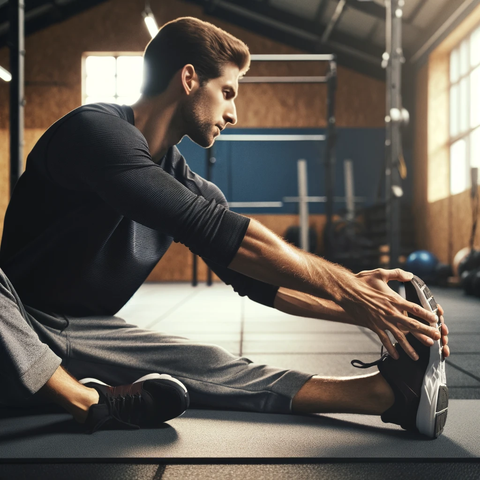Contents (Jump to a section)
How to Prevent Shin Splints When Running on a Treadmill or Concrete

If you’ve ever had shin splints, you will know they are incredibly painful and can keep you sidelined for long periods of time. Shin splints are very common in runners and can lead to severe long-term injuries like stress fractures if left untreated.
In this article, we’re going to take a look at why shin splints occur, how to prevent shin splints when running, and some quick tips for treating shin splints.
Symptoms of Shin Splints
Shin splints often manifest as a sharp pain or throbbing sensation along the inner edge of the shinbone (tibia). Common symptoms include:
- Pain during or after exercise: Pain typically occurs when engaging in physical activities, especially those involving running or high-impact movements.
- Tenderness and swelling: The affected area may be tender to the touch, and swelling can occur around the shin.
Risk Factors for Shin Splints
Certain factors may heighten the likelihood of developing shin splints. These risk factors include:
- Running on hard surfaces: Regularly running on concrete or other unforgiving surfaces increases the impact on the shins.
- Flat feet or overpronation: Poor foot mechanics can contribute to shin splints. Individuals with flat feet or those who excessively roll their ankles inward may be more susceptible.
- Inadequate warm-up or stretching: Failing to properly warm up or stretch before physical activity can strain the muscles and lead to shin splints.
- Previous history: Individuals who have experienced shin splints in the past may be more prone to recurrent episodes.
Causes Of Shin Splints When Running
Shin splints usually occur after repetitive physical activity, such as the motion of your feet slamming down on the sidewalk (or treadmill) when you run. This causes the muscles, tendons, and connective tissue around your shin bone (tibia) to become inflamed. This inflammation is what makes shin splints so painful.
Often, shin splints occur when there are sudden changes in the frequency of your runs, or in the distances that you are running. These changes can put undue stress on the shin muscles, leading to inflammation and shin splints.
Is it Possible to Learn How to Avoid Shin Splints When Running in the First Place?
Shin splints can cause debilitating pain that can keep you off the running track for months. Rather than treating shin splints, a better option is to avoid this painful injury in the first place. When it comes to preventing shin splints when running, there are definitely some steps you can take to reduce your chances of developing shin splints. Let’s take a look at the six best tips for how to avoid shin splints when running.
How to Stop Shin Splints When Running on a Treadmill or Concrete: 6 Ways to Protect Yourself
By following these tips, you give yourself the best possible chances of preventing shin splints when running.
Stretch Your Calves & Shins Regularly

Stretching is key when it comes to preventing shin splints when running. Stretching your calves both before and after a run can not only help prevent shin splints but can also ease tight calves & knee pain. Using flexibility equipment can make your stretching even more effective as you can better target the main calf muscles - the gastrocnemius and soleus muscles.
The CastleFlexx tool makes it easier than ever to stretch your calves effectively to prevent shin splints when running. The best part is that you can use the same device to do stretches for tight glutes, hamstrings, and other muscle groups, and improve your flexibility. So, how long does it take to get flexible calves? Not long with the CastleFlexx!
If you’re wondering how to prevent shin splints when running, the CastleFlexx can be used for stretching both your upper and lower calves. It’s easy to use and barely takes up any space in your gym bag, making it a great solution for how to prevent shin splints when running on a treadmill. Use the CastleFlexx to prevent shin splints and discover the many benefits of assisted stretching.
Gradually Increase Intensity/Volume in Your Training
One of the leading causes of shin splints is an increase in the distance you are running or the frequency of your runs. If you suddenly start running every day when you were previously only running twice a week, there’s a good chance this sudden, extra stress could lead to shin splints.
So, the question is how to avoid shin splints when running frequently? Basically, you need to gradually increase your distances. The general rule is that you should only increase your total mileage by 10% each week, and you should only run 3-4 days a week. Use the other days to cross-train, rest, or try some active recovery like fascial stretch therapy.
Strengthen the Tibia & Other Surrounding Muscles

If you're wondering how to prevent shin splints when running, strengthing the muscles around your shin and calf area is a great place to start. This makes these muscle groups less prone to stress and better able to deal with the repetitive, constant motion of hitting the ground when you run.
One particular muscle to focus on is the tibialis anterior, which is responsible for stabilizing the ankle joint as the foot hits the floor. You can strengthen this muscle by doing simple exercises like toe raises - simply sit on a chair with your feet on the ground in front of you, lift your toes off the ground, and hold for 1-2 seconds before gently lowering back down.
How to Run to Avoid Shin Splints

Learning how to run to avoid shin splints is very important, particularly for serious runners looking to increase their distances. Try to focus on your form every time you run, and make sure you are running correctly. For example, try to land on the ball of your foot, not your heel, even when you are running downhill.
Another common mistake runners make is flexing their toes upwards before they land. Keep your foot and shin muscles relaxed, bend your knees, and stop running if you feel any aches or pains. Always think about how to run to avoid shin splints as you are running.
What Type of Running Shoe is Best for Preventing Shin Splints?
Your shoes matter when it comes to preventing shin splints when running. Good quality running shoes that fit properly and offer solid cushioning and support can help reduce the stress that’s placed on your shin and calf when your feet hit the ground.
Good shoes are particularly important in terms of how to prevent shin splints when running on concrete or uneven surfaces. Even the best quality shoes will eventually wear and start to provide inadequate support, so it’s a good idea to replace your shoes every 300-500 miles.
Give Your Body Time to Rest & Recover
Another tip for preventing shin splints when running is to give yourself plenty of rest and recovery days. It’s recommended to only run 3-4 days a week, and use the other days for cross-training (such as cycling for cardio, yoga for flexibility, or weight training for strength) or pure rest.
Given that shin splints are caused by repetitive motion and too much wear, recovery and rest really are how to avoid shin splints when running. Remember that shin splints can lead to more severe stress fractures, so stop running and rest whenever you feel pain or discomfort.
Quick Tips for Fixing Shin Splints if You Already Have Them
Even after learning how to prevent shin splints when running on a treadmill or concrete, many runners are still affected by this injury at some stage. If you do experience shin splints, you’ll be relieved to know that the condition is at least treatable.
The first step is to rest. Avoid running and any other activities that are painful. If you can, try some low-impact activities like cycling or swimming while you heal. Applying ice to your shins helps to relieve the pain. You can apply ice for 15 minutes, up to six times a day. You can also try over-the-counter pain relief and learn how to stretch shin splints. Don’t get back to your usual running routine until after you’re no longer experiencing pain.
Key Takeaways
So, that’s how to prevent shin splints when running on concrete or a treadmill. By investing in good shoes, working on your form, slowly increasing the distances you are running, and strengthening the muscles in your lower leg, you can reduce your chances of developing shin splints.
Of course, the key to preventing shin splints is regular stretching of your calf muscles and related muscle groups. Stretch before and after your runs, and on your recovery days. Stretching is made much easier and more effective with the CastleFlexx, the number one choice in stretching and flexibility equipment.
Get your CastleFlexx today and never worry about shin splints again!
